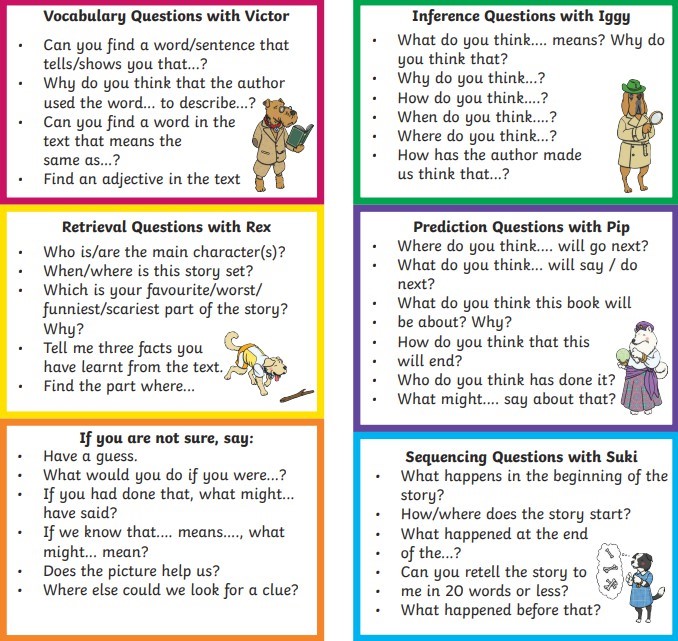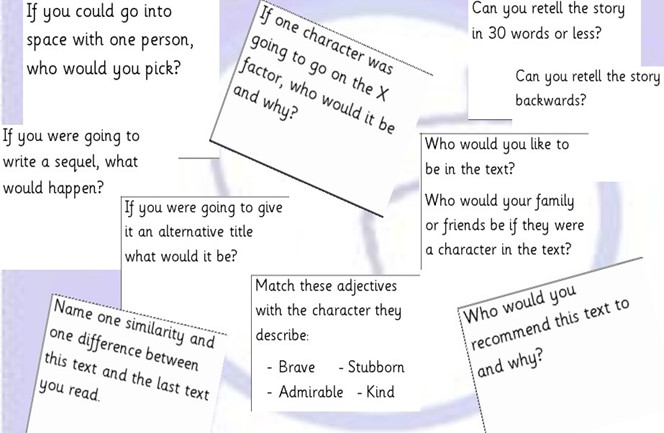In school, your children will experience a range of reading opportunities, which include:
Unlocking Letters and Sounds
Unlocking Letters and Sounds Guided Reading
Comprehensions
Listening to stories
Being heard read by an adult (at least once a week)
Independent reading
In school, your children will experience a range of reading opportunities, which include:
Unlocking Letters and Sounds
Unlocking Letters and Sounds Guided Reading (Term 1-3)
Active Reading from (Term 4-6)
Comprehensions
Listening to stories
Being heard read by an adult (at least once a week)
Independent reading
In school, your children will experience a range of reading opportunities, which include:
Whole class Active Reading
Independent reading
Being heard read by an adult (at least once every two weeks)
Comprehensions
Research ad reading in the wider curriculum
Listening to stories
Some of these will happen in English lessons but equally, children will have these opportunities across the curriculum.
It is expected that children will continue to develop their reading at home through reading with adults and older siblings and completing allocated home learning tasks.

Unlocking Letters and Sounds Phonics is a synthetic phonics programme that provides everything needed to help children succeed in early reading.
The teaching program and reading books are grouped in a developing order based on the order of sounds introduced in synthetic phonics programs.
At Woodlands Academy, we teach phonics every day to our children.
Each child will be given a book to take home which focuses on the sounds they need to practise.
Books will be changed weekly and children will need to have read their books at least three times at home. They will be heard reading aloud by an adult in school before their books are changed. Books will be changed on a Thursday.
Alongside Phonics, children in Reception, Year 1 and Year 2 will have weekly Unlocking Letters & Sounds Guided Reading Sessions. In these sessions, there will be a book talk, phonics focus, blending focus, vocabulary, independent reading, reading fluency and comprehension. The guided reading sessions are matched with where the children are in their phonics lessons.
At Woodlands Academy, in Key Stage Two and from Term 4 in Year 2 children are taught a balance of reading strategies through whole class Active Reading sessions.
Active Reading takes 4 days a week in 30 minute sessions. Each week the children will look at a text and become fully immersed in it. Children will be given the opportunity to practise their fluency skills through multiple reading aloud strategies (teacher modelling/echo/choral/paired reading).
During Active Reading lessons children will look at understanding and broadening their vocabulary as well as using a variety of strategies combined to unpick and understand a text.

Regular comprehensions are taught as part of English. These may or may not be linked to a specific genre or text.
Comprehensions can be published or written by teachers to expose the children to different genres of text linked to their learning.
During reading comprehensions pupils will have opportunities to apply the reading strategies taught during Active Reading.
Comprehensions should include questions that cover some or all of the specific reading objectives and cover a range of text types, fiction, non-fiction and poetry.
· Standardised comprehensions will be used to test children at various points throughout the year. This information will then be used to assess the children’s learning so far, and to identify any areas of their learning that they may need to develop further through class teaching/interventions.
From the end of Year 2 (or earlier if required) up to Year 6, pupils’ individual reading books will be taken from levelled Accelerated Reader books. At the start of the year, pupils in KS2 will take a star reader test to determine which level books they should be reading. They will be given a ZPD level range to select books from.
As soon as a pupil has finished their book, they must take a quiz online. The quiz will assess children’s understanding of what they have read and whether they are ready to move up to the next level.
At regular points throughout the year pupils will retake the star reader test to be given a new ZPD range.
For every Accelerated Reader quiz completed, the number of words a child has read in the book will be added to their profile. Throughout the terms we will collate how many words each class and child has read and celebrate this in assembly.
Children will be given daily opportunities to read their reading book to themselves silently.
During this time, adults will read with individuals.
Children may also quiz on their Accelerated Reader books during this time.
When hearing readers, we ensure the atmosphere is purposeful and that the child feels comfortable.
All children will be heard read at least once a week in Key Stage One and once every two weeks in Key Stage Two, with targeted readers identified and heard read more frequently.
Each week your child will be expected to read at least three times at home. In Key Stage Two, this will be their Accelerated Reader book or, if your child is not reading at an Accelerated Reader level, they will bring home an appropriate book that matches their reading level.
Children may also bring home a library book of their choice, which they can read to themselves or have read to them by an adult.
Please encourage your children to read the book to you, or independently, until they are familiar with the words and demonstrate a good level of understanding.
All children in the school are given a Reading Record Book. We ask that you sign and date when you hear your child read at home and make a comment when you hear your child read. Year 5 and 6 children can fill in their reading diary independently.
Children can use their home reading to count towards their Karate Reading bands (see below).
For every 25 reads completed at home and recorded in their reading diary, pupils can earn coloured karate reading bands that they can wear to school. These will be presented in assembly on a Friday.
White band ~ 25 ‘reads’
Yellow band ~ 50 ‘reads’
Orange band ~ 75 ‘reads’
Green band ~ 100 ‘reads’
Blue band ~ 125 ‘reads’
Brown band ~ 150 ‘reads’
Black band ~ 175 ‘reads’
Try to build reading at home into your daily routine.
Have a quiet, comfortable space your child (and you) can read in.
Read with your child and read in front of your child.
Remember, both reading and hearing texts read aloud are important.
If it is the first time your child has read the book, look at the cover and title with them to predict what they think the book might be about. Make links to other books read with similar themes, the same characters and/or similar authors/illustrators. Give them time to flick through the book and read the blurb.
Encourage children to track the words with their finger or use a reading ruler if needed.
Help the children to decode (read) the words and ask them about the meaning of more challenging words.
Ask children about the content of what they have read – who, what, where, when, why, how?
Ask your child questions to check their understanding of the text.
Here are some ideas of questions that could be asked:


